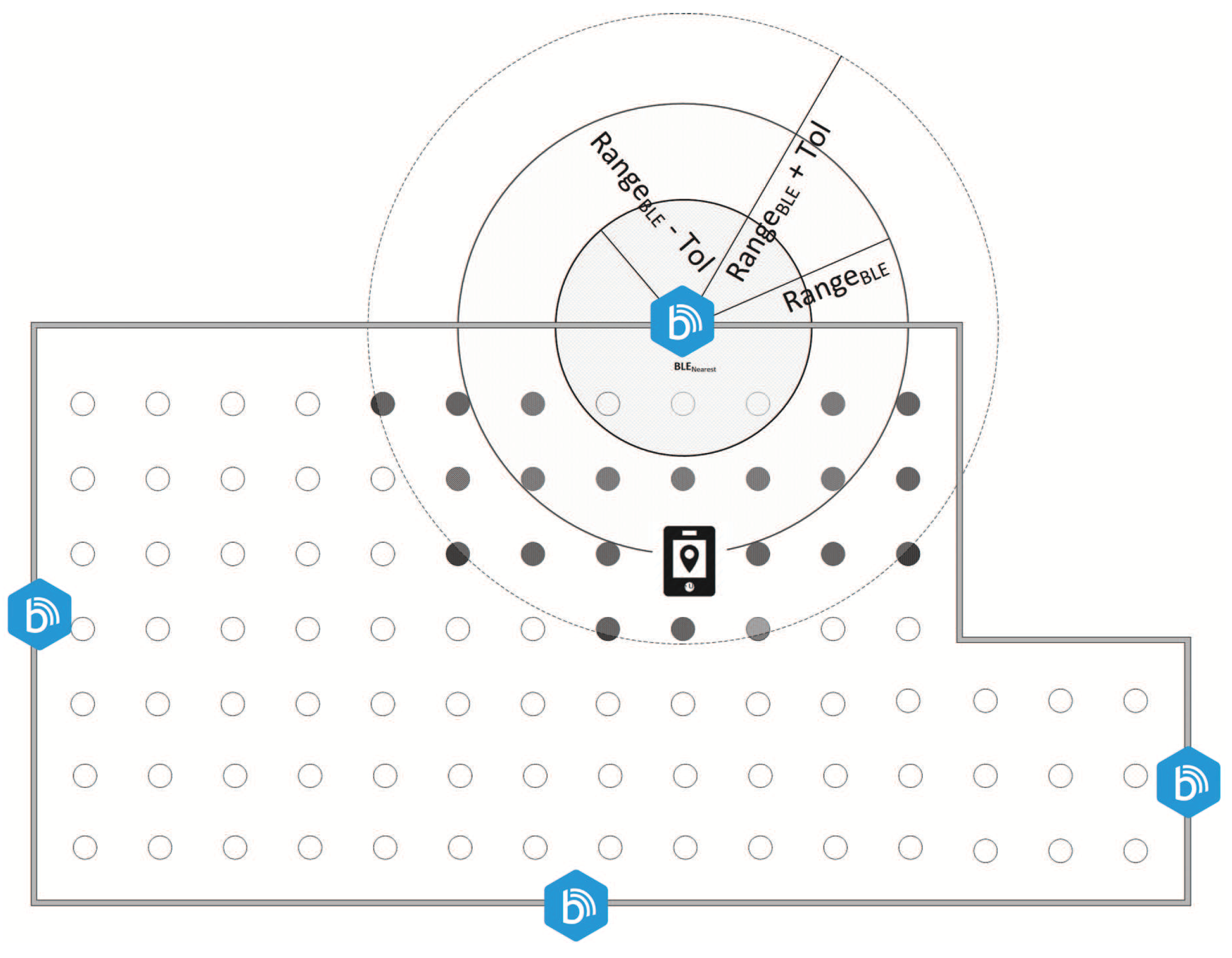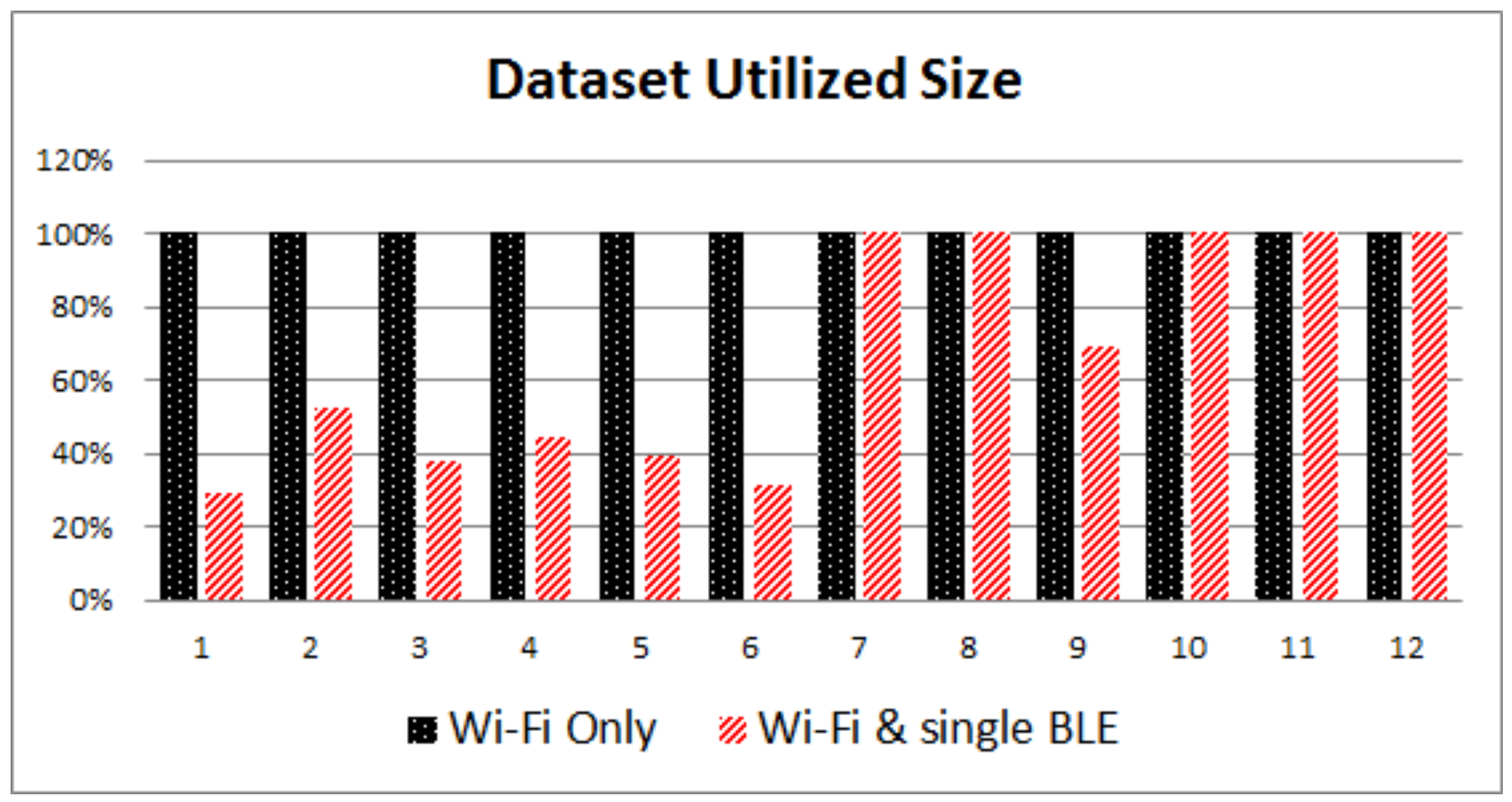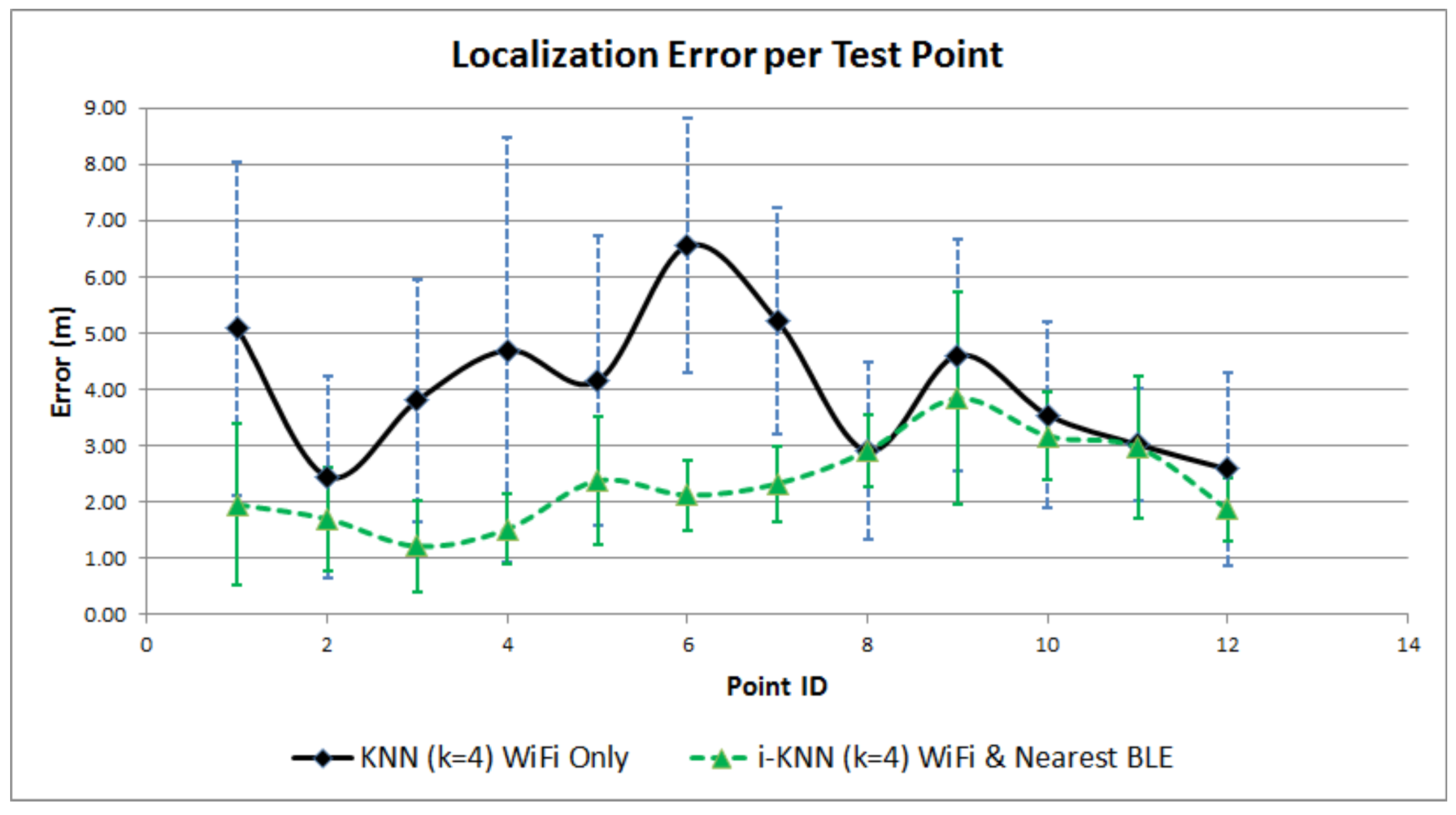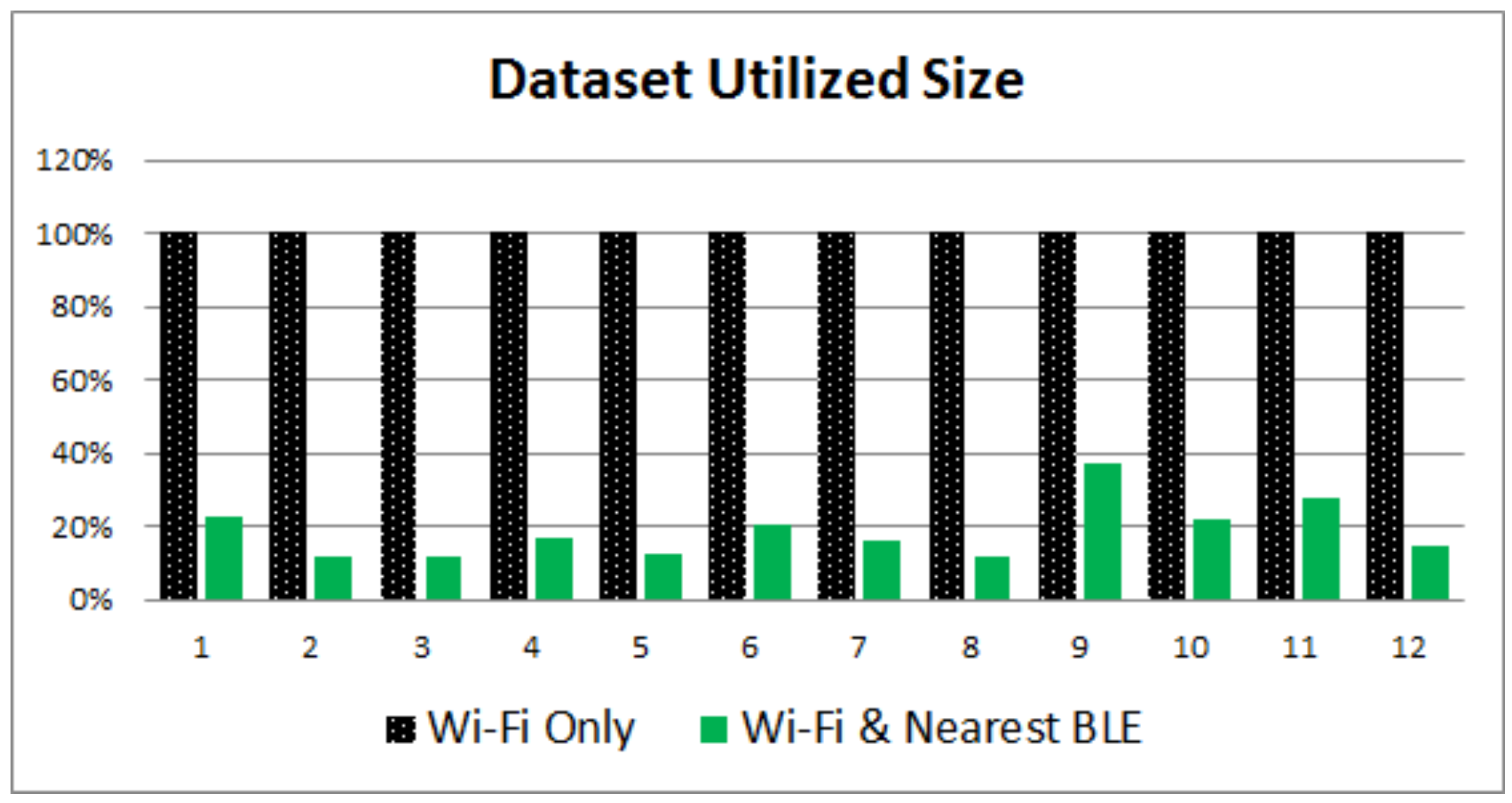2.1. Radio RSS Fingerprint-Based Indoor Positioning Methods
RSS fingerprint–based positioning methods are utilized in various wireless technologies (IEEE 802.11, IEEE 802.15.4, etc.). The main advantage of these methods is the relatively low complexity of the positioning system, which utilizes existing infrastructure, rather than requiring the deployment of specialized equipment. The positioning algorithms retrieve the RSS at the user location and implement either deterministic or probabilistic methodologies to estimate the actual user location. The concept that lies behind both methodologies is common; searching a database of fingerprints and identifying one or more positions whose RSS signature has the
highest similarity with the observed one. More specifically,
deterministic positioning methods estimate location
as a convex combination of the
K reference locations with the shortest distance between
and
s in the
n-dimensional space [
19,
20,
21]. The aforementioned statement is mathematically expressed with the following equation:
The set
denotes the ordering of reference locations with respect to increasing distance
, which is measured between the respective database fingerprint
and the observed measurement during positioning
s, i.e.,
. The distance can be calculated using standard norms, such as the Manhattan (1-norm) [
22], the Euclidean (2-norm) [
23] or the Mahalanobis norm [
24]. Focusing on the Euclidean distance,
can be expressed by the following equation:
The non-negative weight coefficient
in Equation (
1) represents a value that can be allocated to each reference location in the radiomap and differentiates its weight, hence its importance from other fingerprints. In other words, the value of this
coefficient may vary in a way that each fingerprint influences differently the positioning estimation. In such a case of weight allocation, Equation (
1) expresses the Weighted
K-Nearest Neighbour (WKNN) algorithm [
22]. A typical value for
can be the inverse of
. Simplifying the aforementioned algorithm, it can be assumed that equal weights are allocated to all utilized fingerprints. Such an assumption results in the elimination of
and the equation is converted to the
K-Nearest Neighbour (KNN) method. Finally, setting
, the formula leads to the simple Nearest Neighbour (NN) method [
23,
25]. According to [
22,
23], KNN and WKNN methods provide higher positioning accuracy compared to the NN, for
and
. On the other hand, NN seems to perform satisfactorily and provides equally good results in scenarios with high density RSS radiomaps [
19]. More complex deterministic algorithms are discussed in literature, such as the linear discriminant analysis [
26] and the Database Correlation Method (DCM) [
27]. They generally claim better localization accuracy but at a higher computational cost.
In probabilistic methods, location ℓ can be estimated by calculating and maximising the conditional posterior probabilities , where , given an observed point s and a reference radiomap of l fingerprints.
The posterior probability
is obtained by applying Bayes’ rule:
where
is a conditional probability calculated through statistics at the survey stage and
is the a priori probability, a weighting factor based on the probability distribution of the observation over the reference position candidates included in the fingerprint database. In case of no prior knowledge, this
prior is assumed to be unity, meaning that all fingerprint candidates have equal a priori probability. Probabilistic methods have been used in the Maximum A Posteriori (MAP) approach [
28] and the Minimum Mean Square Error (MMSE) approach [
29] to estimate the expected value of
ℓ.
In a continuous effort for improving localization accuracy in fingerprint-based systems, the research community investigated the fusion of data retrieved by the indoor mapping of buildings. Towards this direction, Evennou et al. in [
30] proposed the use of particle filters to make use of the inherent structure of indoor environments, while, more recently, Kokkinis et al. in [
21], proposed a method of imposing map-constraints into the positioning algorithms in the form of a-priori knowledge. Finally, the fusion of information received by several sources was examined in [
31], while the incorporation of wearable devices for indoor localization was also investigated in [
14].
2.2. BLE and the iBeacon Technology
BLE was introduced as part of Bluetooth 4.0 specifications, allowing the devices to support both BLE and classic Bluetooth protocols simultaneously [
32]. The power efficiency of Bluetooth with low energy functionality was especially created for IoT applications. It allows devices to run for long periods on extremely low power sources, such as coin-cell batteries or energy-harvesting devices.
BLE operates at 2.4 GHz and uses Gaussian Frequency Shift Key (GFSK) modulation in 40 channels of 2 MHz. Three of the channels, called “advertising channels”, are used to ensure connectivity with other nodes, while the remaining 37 are the “data channels”. BLE has a range of around 100 m in an outdoor environment, a maximum data rate of 1 Mbit/s and an application throughput up to 305 kbit/s [
32]. Finally, it supports point-to-point and mesh networks.
iBeacon was developed by Apple (Cupertino, CA, USA) in order to provide a higher level of location awareness, by utilizing the BLE technology. iBeacon is a cross platform technology for both Android and iOS devices that are able to support the BLE standard [
33]. Devices, acting as beacons, generate iBeacon advertisements through which they establish a region around them. Android and iOS mobile devices receiving the advertisements can determine the entrance and exiting borders from each Beacon’s region, can estimate the nearest beacon and can approximate the distance between the two devices. The aforementioned advertisements contain three identifying fields, as described in [
34]:
UUID: Universally Unique Identifier is a 128-bit integer used as an ID for all beacons in an application;
Major: is a 16-bit integer, used to differentiate Beacons with the same UUID;
Minor: is a 16-bit integer used to further differentiate Beacons that have the same UUIDs and Major values.
Due to their design philosophy, iBeacons are flexible in deployment and can be used in mobile objects or to temporarily define a region and subregions.
The possibilities introduced by BLE and iBeacon technologies in indoor positioning are currently a topic of investigation from the research community. The authors of [
35] proposed a software framework that can be used to automate IoT applications based on the proximity triggered by AltBeacon devices. AltBeacon is an open and interoperable specification that defines the format of the advertisement message that BLE proximity beacons broadcast. In [
36], InLoc is introduced, which is a positioning and tracking system using commercial mobile devices, with a navigation (routing) capability. With InLoc, the authors propose, among others, a method for independent fusion of location information from phone Inertial Measurement Unit (IMU) sensors and BLE beacons. In [
37], the authors propose a solution for the creation of study groups in future smart libraries, featuring a smart-phone application to create study groups and a hybrid BLE and Wi-Fi indoor positioning system. Their hybrid indoor positioning system calculates two probable user locations every time, utilizing each technology separately, compares the estimated conditional probabilities and selects the most reliable. Following a different approach, researchers in [
38] assume a very dense IoT environment with BLE compatible devices and propose an Iterative Weighted KNN (IW-KNN) indoor localization method based on RSS of the BLE, which has a low power consumption and hence a long life expectancy. Finally, a combination of Wi-Fi and BLE fingerprints was implemented in [
39], utilizing the conventional WKNN algorithm. The test case included the deployment of 17 Estimote BLEs (Estimote Inc., New York, NY, USA) on top of the existing Wi-Fi network, in a study area of 52 m × 43 m. Positioning was performed by utilizing both BLE and Wi-FI RSS fingerprints, resulting in a
accuracy improvement of the RTLS system.














